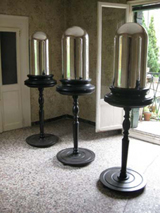Distortion' - a project for the 53rd Venice Biennale, 2009
An exhibition at The Gervasuti Foundation, Fondamenta S.Anna (Via Garibaldi), Castello 995, Venice -7 June - October - 22 November 2009. Participating artists:- Janet Cadiff & George Bures Miller, Oliver Clegg, Mat Collishaw, John Isaacs, Alastair Mackie, Tim Noble and Sue Webster, Jamie Shovlin, Gavin Turk
Distortion has been a significant feature of creative expression throughout the history of art. In his notebooks, Leonardo da Vinci, described a bizarre use of perspective to create an anamorphosis, a deliberately distorted image almost unrecognizable at first sight but when viewed from a certain angle turns to a normal appearance. Staged in Venice, this project is intended in part to celebrate the tradition of the great 16th century Venetian painters, like Jacopo Tintoretto (1518-1594) who used distortion to achieve dramatic effect. Distortion affects the perception of an image and depends upon the changes that the thing undergoes in the process of becoming an æsthetic object. It can combine elements of both the comic and grotesque in stylistic distortions of the human form - strangely disproportioned figures and the expressive deformation of particular features. Rather than making an image ‘worse’ it merely represents a change in the original image’s information. This alteration can be more pleasing to human perception than if the image was ‘perfectly’ regular. In the genre of rock music much of its’ appreciation relies on ‘beauty’ of guitar distortion achieved by overdriven valve amps and fuzz pedals.
Distortion is due to the fact that abstractions from the norm are both made, and seen. It can be either formal or emotional, and presupposes an order from which to deviate and in representation it must have a recognizable reference to the norm, such as a distorted circle. While the artist’s mind strives for compositional symmetry and harmony, it also has a penchant for creating imbalance and distortion. Distortion expresses both the strength and the vulnerability of the human psyche. It also represents a transgressive form of creativity that evokes a darker view of the world or the universal anxieties that affect the human condition. It has been used intentionally for expressive and emotional ends in contemporary art where not only figures, but also objects, scale and space can be distorted. One of its most significant aspects that now affect our daily lives is the distortion of the ‘truth’ by the media and the manipulation of digital images. Previously regarded as being merely a form of mannered exaggeration or an imaginative conceit, distortion was thought to be an abnormal, minor aspect of artistic output. But in our contemporary culture, it has become increasingly evident that distortion is something important and vital to all creative expression.
LINK http://www.labiennale.org/en/art/click here
http://www.youtube.com/watch?v=Uq1cHlaCmOA
|
|
 |